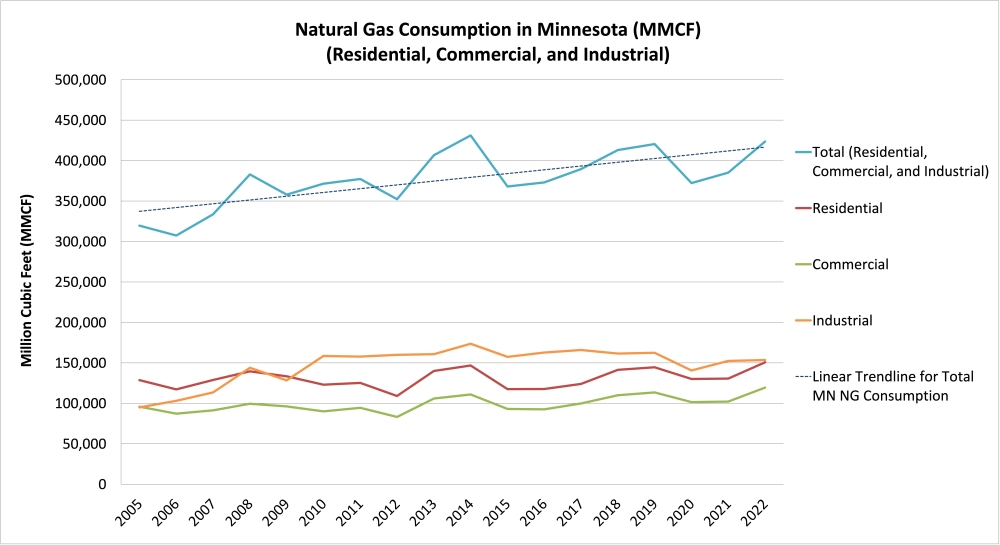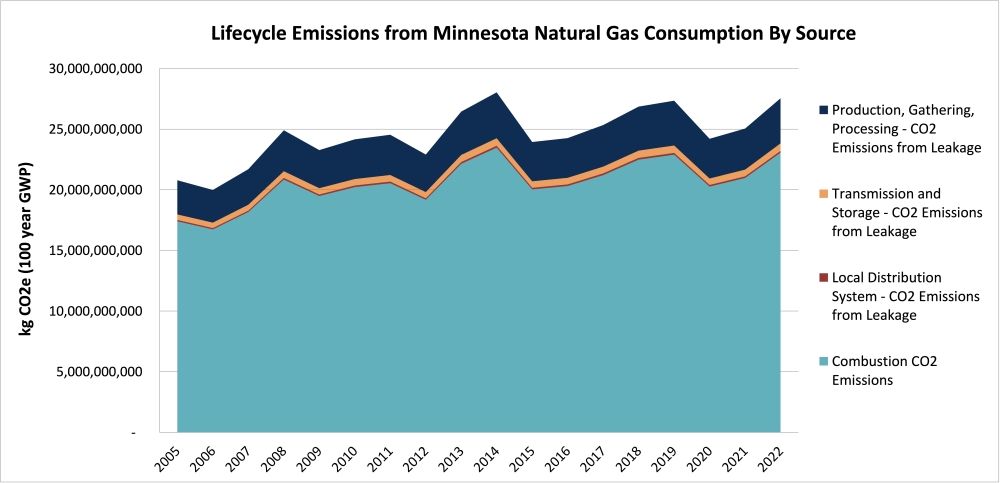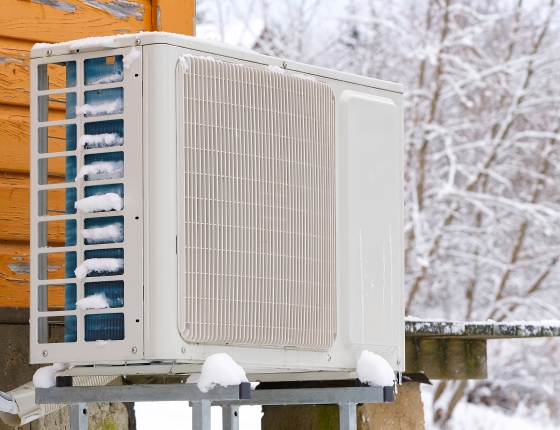Natural gas is deeply embedded in Minnesota's economy. Two-thirds of our households depend on natural gas to heat their homes during Minnesota's extreme winters, while our industrial sector uses it as both an energy source and ingredient in manufacturing processes. We even rely on natural gas to generate 21 percent of our electricity.
However, while natural gas is a key energy source, it is also a fossil fuel that contributes directly to climate change by releasing greenhouse gases like carbon dioxide (CO2) into the atmosphere. To meet Minnesota's goal of net-zero emissions by 2050, Minnesota must address its dependence on natural gas and tackle the challenge of decarbonizing natural gas end-uses.
Given the wide range of essential roles that natural gas plays in Minnesota, it can be daunting to even consider replacing it. The widespread electrification of natural gas end-uses, combined with the rapid uptake of electric vehicles, could strain the electrical grid by increasing demand. Despite advances in technology, electric heating alternatives like cold-climate heat pumps still lose efficiency and the ability to produce the same quantity of heat at very low temperatures, meaning most households in Minnesota will need a secondary heating system. Equity issues arise as well, as electrification measures have historically been expensive and hard for lower income residents to access.
Given these challenges, we will need careful planning to minimize risk as we phase out natural gas. Relying on natural gas as a back-up, at least for the near future, will stabilize the transition more while we incorporate alternative resources.

Source: CEE Natural Gas Analysis
Growing natural gas emissions
CEE's analysis of Minnesota's natural gas consumption (excluding that used for electricity generation) found that, overall, CO2 emissions from the consumption of natural gas increased by 32.6 percent between 2005 and 2022. During this period, per capita emissions increased by 18.9 percent, showing that there are now more people living in Minnesota, each creating more emissions (on average) than two decades ago.
Overall, natural gas consumption in Minnesota and the resulting emissions have increased steadily since 2005. Despite a drop in consumption in 2020, likely due to the COVID-19 pandemic, it quickly began to rise again in 2021. By 2022, Minnesota was producing roughly 23 billion kilograms of CO2 emissions solely from onsite consumption of natural gas, which is equivalent to the emissions from driving 5 million gasoline-powered passenger vehicles for a year.

Source: CEE Natural Gas Analysis
In addition to emitting CO2, the natural gas sector also leaks methane (a potent greenhouse gas) during production, storage, and transportation. In 2022, Minnesota's natural gas consumption resulted in an estimated 190.8 million kilograms of methane into the atmosphere (equal to the greenhouse gas emissions from driving 1.2 million gasoline-powered passenger vehicles for a year). Methane is the primary component of natural gas, and, though it decomposes in the atmosphere faster than CO2, its ability to trap heat is 28 times as strong on a 100-year time scale. Considering Minnesota's commitment to a net-zero future, natural gas emissions from both its consumption and leakage must be addressed.
Policy tools for natural gas decarbonization
While we still have a long way to go to decarbonize the natural gas sector, policymakers at the state and federal level have taken several important steps to spur future decarbonization, including funding for clean energy projects, electrification, and energy efficiency through the Inflation Reduction Act, as well as new Minnesota state incentives for electrification and energy efficiency improvements. Minnesota policymakers also recently passed foundational policy tools to chart our state's path ahead:
- Through the 2021 Energy Conservation and Optimization (ECO) Act, the state legislature updated the long-running Conservation Improvement Program. ECO lets utilities offer a more diverse set of energy saving programs for their customers, including efficient fuel switching and load optimization measures. ECO enables natural gas utilities to help their consumers increase efficiency and better incentivize fuel switching, ultimately decreasing natural gas consumption and emissions.
- The Natural Gas Innovation Act (NGIA), passed by the state legislature in 2021, encourages natural gas utilities to pilot innovative decarbonization technologies and strategies, including those related to renewable natural gas, green hydrogen, geothermal energy, electrification, and energy efficiency. While many of these technologies are still in development or have yet to be deployed, they have the potential to decarbonize energy-intensive industrial end-uses. CenterPoint Energy and Xcel Energy, Minnesota's two largest investor-owned natural gas utilities, are currently awaiting comments on their first proposed NGIA plan.
- In 2022, Minnesota's Public Utilities Commission (PUC) unanimously voted to require regular Integrated Resource Plans (IRPs) from natural gas utilities. Once the PUC establishes the procedure and requirements for natural gas IRPs, Minnesota's three largest gas utilities will periodically submit plans detailing how they will meet consumer demand. With the implementation of the IRPs, Minnesota could require that natural gas utilities prioritize environment considerations in their decision-making processes while ensuring the reliability, safety, and affordability of the system. CEE's comments regarding the process can be found under docket number CI-23-117 of the Public Utilities Commission.
The diverse natural gas end-uses in Minnesota mean that a path to natural gas decarbonization will require multiple solutions. Natural gas may be needed, especially as a back-up heating source, for some time. Going forward, the Minnesota energy sector must maintain its momentum to reduce natural gas consumption and decarbonize the natural gas system by prioritizing a transition toward low-emission alternatives. By setting an example of how to decarbonize natural gas safely and equitably in a cold state that relies heavily on the resource, Minnesota would continue its climate leadership and encourage other midwestern and northern states to do the same.
